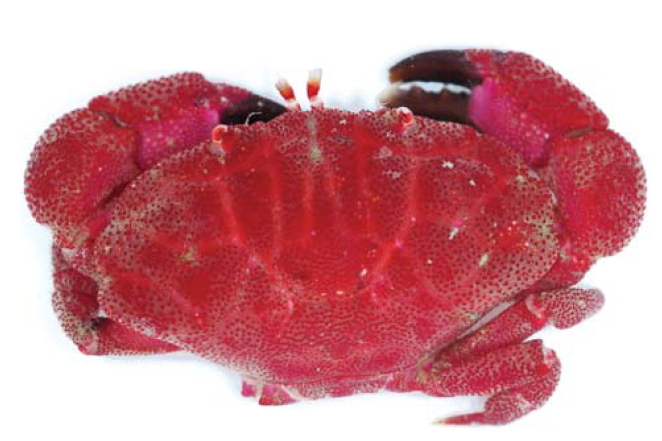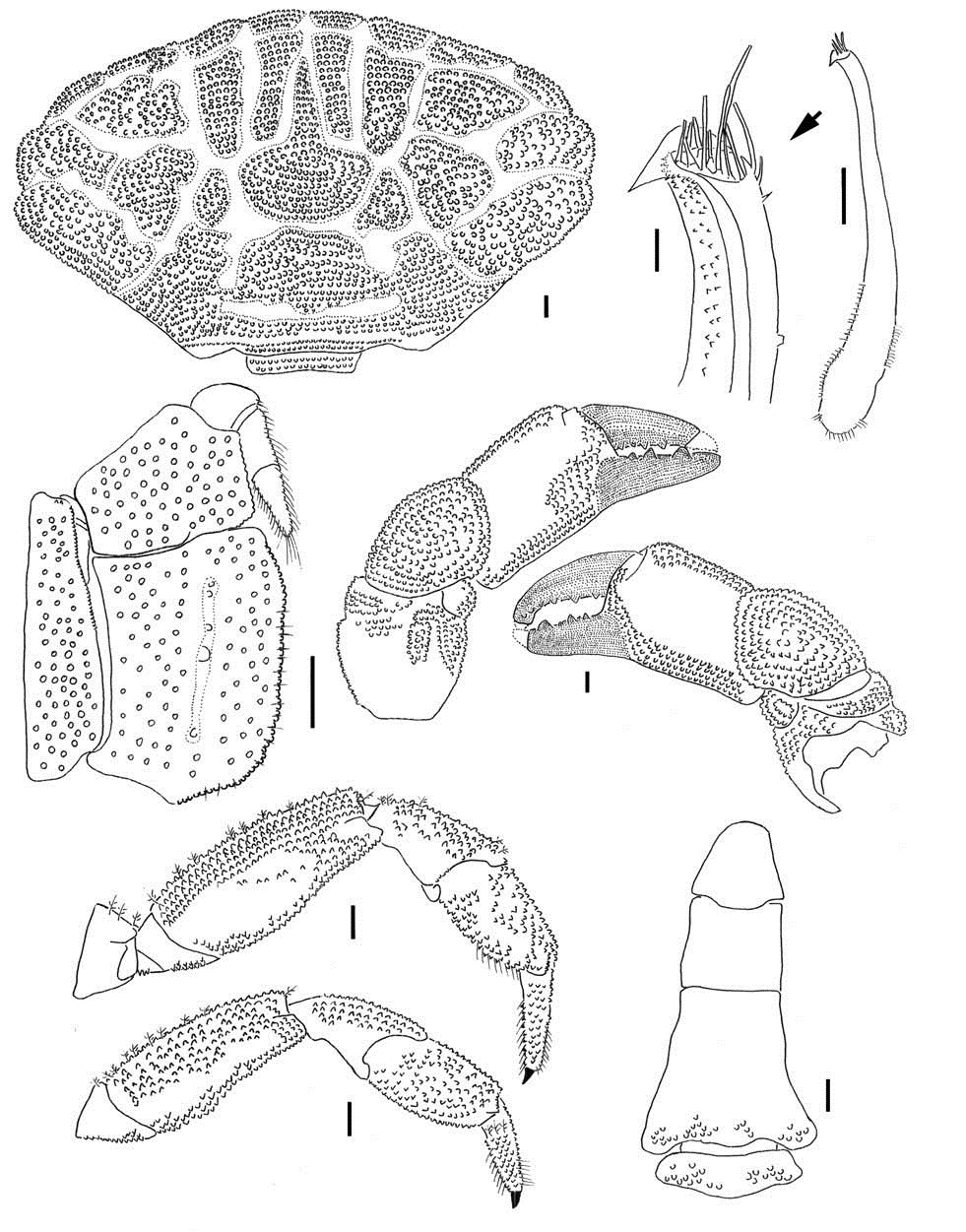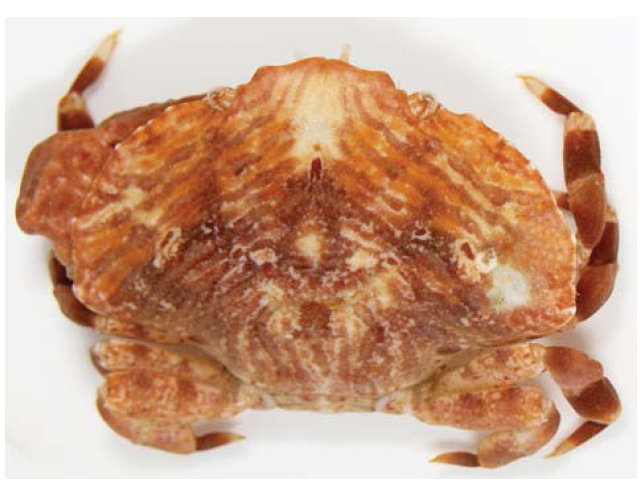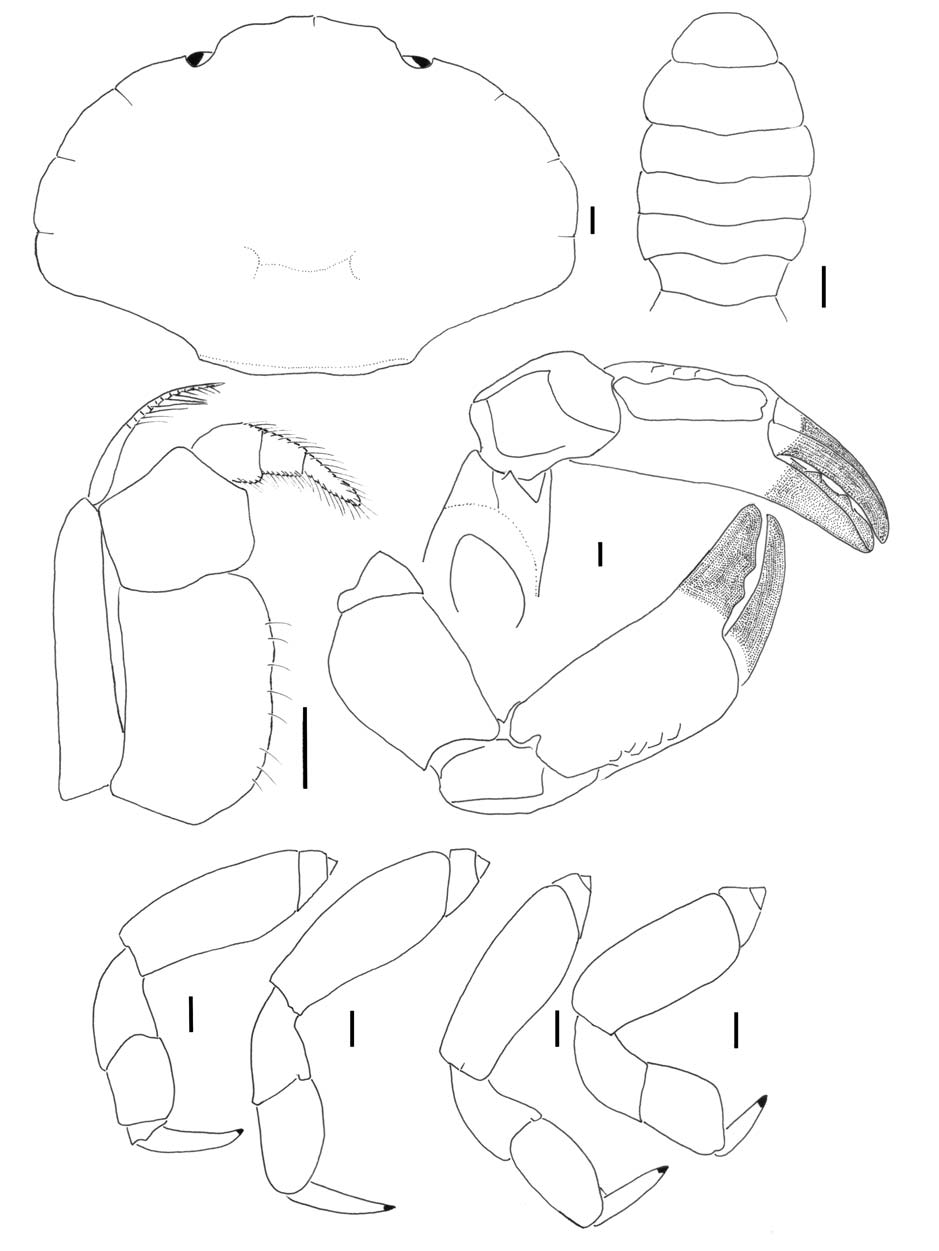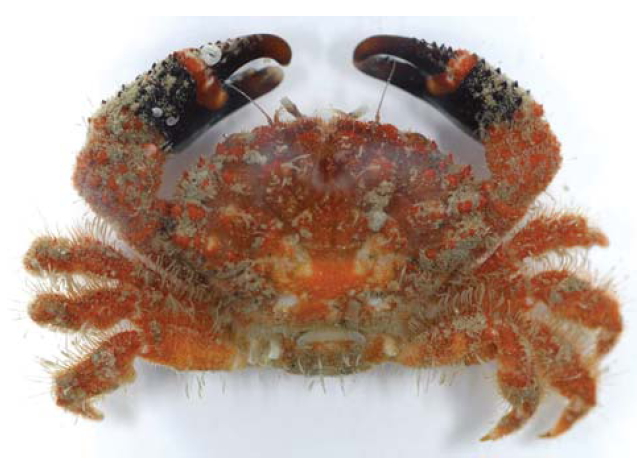



The family Xanthidae is one of the largest families in the Brachyura and includes 628 species of 117 genera of 13 subfamilies (Ng et al., 2008). Currently, 22 species [
Drawings were made with the aid of camera lucida. The abbreviations “cl” and “cw” refer to carapace length from the tip of frontal margin to the posterior dorsal margin of the carapace and to the width of the carapace measured at the widest part, respectively. All specimens were preserved in 95% ethanol. The classification follows that of Ng et al. (2008) and terminology used for carapace regions generally follows
those of Serene (1984). All specimens are deposited at the corresponding author’s collection of Silla University, Busan.
Order Decapoda Latreille, 1802
Superfamily Xanthoidea MacLeay, 1838
Family Xanthidae MacLeay, 1838
Subfamily Liomerinae Sakai, 1976
1*Genus
2*
Materials examined. 1♂ (cl 13.7 mm, cw 23.7 mm), Hyeongjeseom Island, 16 Jun 2009, Ko HS, SCUBA at 25 m depth.
Description. Carapace (Figs. 1, 2A) transversely ovoid, about 1.7 times broader than long, dorsal surface covered with rounded granules except on smooth inter-regional furrows; regions well distinct, separated by strong furrows. 1F and 2F confluent, not separated from frontal margin; 1M and 2M fused but 2M divided longitudinally into 2 parts; 1L to 5L distinct clearly but 2L and 3L fused. 1R and 2R fused; 3R not defined. Anterolateral margins divided into 4 rounded lobes by shallow sinus, margins granulated. Posterolateral margins oblique, somewhat straight. Frontal margin slightly projecting, divided into 2 lobes by narrow fissure.
Third maxilliped (Fig. 2B) punctuated on surface; ischium subrectangular, about 1.4 times longer than broad; longitudinal groove on medially; inner margin granulated and with setae. Antero-external angle of merus produced. Distal half of inner margin of expod granulated.
Chelipeds (Fig. 2C, D) subsymmetrical, slightly short; surfaces of meri, carpi and palm covered with rounded granules except on distomedial surface of palm naked; fingers bluntly pointed, curved, dark brown colored, cutting margins with triangular teeth.
Third and fourth ambulatory legs (Fig. 2E, F) flattened,covered with triangular granules; meri with setae on anterior margins; carpi with setae on distal margins; propodi with long setae on distal half of posterior margins; dactyli with long setae on distal half of margins; tips pointed, curved, dark brown colored.
Male abdomen (Fig. 2G) relatively narrow; segments 3 to 5 fused; segment 6 longer than broad. Telson coniform.
First gonopod (Fig. 2H, H′) relatively long, slender, recurved, with truncated tip; spinules and long setae on distal margin.
Color of in life. Carapace and legs reddish violet, fingers of chelipeds and dactyli of ambulatoy legs dark brown.
Habitat. Crevices of coral reef or under stones.
Distribution. Red Sea, Aden, Madagascar, China, Japan, Indonesia, New Guinea, New Caledonia, Samoa (Sakai, 2004) and now to Korea.
Remarks. Thirty-three species of
Subfamily Xanthinae MacLeay, 1838
3*Genus
4*
Terada, 1982: 169.
Materials examined. 1♀ (cl 12.2 mm, cw 18.7 mm), Hyeongjeseom Island, 16 Jun 2009, Ko HS, SCUBA at 25 m depth.
Description. Carapace (Figs. 3, 4A) naked, fan-shaped,about 1.5 times broader than long; regions not defined; surface convex medially. Anterolateral margins arched prolonged far backward, sharply crested, divided into 4 lobes by 3 narrow fissures. Posterolateral margins slightly concaved.Frontal margin well produced, directed downward; divided into 2 lobes by longitudinal fissure.
Third maxilliped (Fig. 4B). Ischium subrectangular, about 1.4 times longer than broad; bearing setae on inner margin; antero-external angle of merus produced.
Left cheliped (Fig. 4C, D) relatively long, robust; anterior margin of carpus crenulated; palm long, slender, proximal and anterior margins crenulated; fingers slender, curved,brown colored; cutting margin of fixed finger with 2 triangular teeth.
Ambulatory legs (Fig. 4E-H) naked, generally short, stout, flattened; fourth ambulatory legs shorter than others; dactyli long, tips bluntly pointed, brown colored.
Female abdomen (Fig. 4I) elongated, 6-segmented. Telson semicircular, broader than long.
Color of in life. Red diagonal lines distributed on lateral each half on carapace, fingers of chelipeds and proximal parts of propodi and dactyli of ambulatory legs are dark brown.
Habitat. Crevices of coral reef and under stones.
Distribution. Red Sea, Aden, Kenya, Zanzibar, Madagascar, Japan, Taiwan, Australia, New Caledonia (Sakai, 2004) and now to Korea.
Remarks.The genus
Subfamily Chlorodiinae Ng and Holthuis, 2007
Genus
1*
Materials examined. 1♂ (cl 7.5 mm, cw 13 mm), Hyeongjeseom Island, 16 Jun 2009, Ko HS, SCUBA at 25 m depth.
Description. Carapace (Figs. 5, 6A) convex, transversely ovoid, about 1.7 times broader than long; regions well defined, elevated, separated by strong furrows, covered with irregularly granules and setae. 1F and 2F fused. 1M produced, with 3 spines anteriorly. 2M divided into longitudinally. 3M tripartite, anterior lobe surpassing anterior margin of 2M. 1L to 5L distinct clearly. 1P and 2P distinct clearly, 2P disjuncted medially. Anterolateral margins divided into 4 spines,tuberculated; apical spine directed anteriorly, yellowish brown colored. Posterolateral margins oblique, somewhat straight. Frontal margin arched, granulated; divided into 2 lobes by U-shape notch.
Third maxilliped (Fig. 6B) punctuated on surface. Ischium subrectangular, about 1.5 times longer than broad, inner margin granulated and with setae, longitudinal groove on medially;antero-inner margin with small spines; merus with setae on inner margin; antero-external angle produced, with small spines; dactylus setose, with spines medially
Chelipeds (Fig. 6C, D) asymmetrical, relatively long, robust, covered with granules and setae; palms long, slender, conical
tubercles over upper surfaces while lower surfaces naked, black colored band encircled except distal margins; fingers massive, tips bluntly pointed, black colored; cutting margins of both fingers with triangular teeth; 2 rows of conical tubercles from proximal to medial parts on upper margins of movable fingers.
Ambulatory legs (Fig. 6E-H′) generally short, robust,covered with granules and setae; fourth ambulatory leg shortest; meri with spines on anterior margins; dactyli with spines on both margins, dactyls pointed end, tips curved, black colored.
Male abdomen (Fig. 6I) relatively narrow; segments 3 to 5 fused; lateral margins slightly concaved. Telson coniform.
Gonopods (Fig. 6J-K). First gonopod long, slender, recurved;proximal parts of both margins with setae; spoon-shaped tip, setose, with spines disto-medially. Second gonopod short, straight; proximal part of inner margin convex, with setae; tip spear-shaped.
Color of in life. Generally reddish brown. Palms and fingers of chelipeds black.
Habitat. Crevices of coral reef.
Distribution. Australia, China, Japan, Singapore (Clark and Galil, 1993) and now to Korea.
Remarks. Until now,
Korean name: 1*주름부채게속 (신칭), 2*주름부채게 (신칭), 3*줄무늬부채게속 (신칭), 4*줄무늬부채게 (신칭) Korean name: 1*검은손부채게 (신칭)

